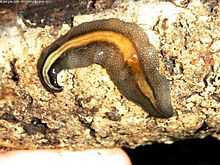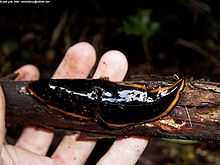Geoplanidae
| Geoplanidae | |
|---|---|
 | |
| Geoplana burmeisteri from the Atlantic rainforests of southern Brazil | |
| Scientific classification | |
| Kingdom: | Animalia |
| Phylum: | Platyhelminthes |
| Class: | Turbellaria |
| Order: | Tricladida |
| Suborder: | Continenticola |
| Family: | Geoplanidae Stimpson, 1857 |
| Subfamilies[1] | |
| |
Geoplanidae is a family of flatworms known commonly as land planarians. It is an understudied but important group of organisms of soil ecosystems.[2]
These flatworms are predators of other invertebrates such as earthworms, snails, slugs, insects and chelicerates, which they hunt, attack and capture using physical force and the adhesive and digestive properties of their mucus.[3] They lack water-retaining mechanisms and are therefore very sensitive to humidity variations of their environment.
Because of their limited ecological requirements, some species have been proposed as indicators of the conservation state of their habitats.[4][5] They are generally animals with low vagility and with very specific habitat requirements, so they can be also used to accurately determine the distribution of biogeographic zones. Today the fauna of these mostly rather fragile animals is being used to select conservation priorities in the Atlantic rainforest in southern Brazil.
At the other extreme, one species in this family, Platydemus manokwari has become an invasive species in both disturbed and wild habitats in the Pacific Islands, and has damaged the endemic land snail faunas.
Diversity
The family Geoplanidae is composed of four subfamilies:
- Rhynchodeminae: the oldest family, characterized by having only two eyes in the anterior end of the body
- Bipaliinae, consisting of Asiatic species that have a half-circle head shape
- Geoplaninae, the most modern family of terrestrial flatworms; it includes land planarians from South America and Oceania
- Microplaninae
Although there are over 830 known species of Geoplanidae in the world,[6] the diversity of land planarians is still poorly known.
Feeding and predatory behavior

"If contact with food is made, and the planarian is ready to feed, arousal and predatory behaviour will occur" (Neck, 1987)
Despite their delicate aspect, these terrestrial flatworms are voracious predators. All planarians feed through a muscular and eversible pharynx located in ventral side of the body. The pharynx is an extensible tube-like mouth, it bears complex muscular coat that specialized as a penetration organ for those planarians that feed on arthropods; or as a grasping for those planarians that feed on other soft bodied invertebrates such as earthworms. All pharynxes are equipped with glandular secretions that externally digest and dissolve their prey.[3]
As part of the soil ecosystem, land planarians feed mainly on other invertebrates. Some species of land planarians have become invasive pest species. The New Zealand flatworm Arthurdendyus triangulatus and the Australian flatworm Caenoplana alba have been introduced in the British Isles and are considered to be pest species because they prey upon earthworms and thus may negatively affect soil structure and fertility. A species of land planarian, Platydemus manokwari, has been used as an agent of biological pest control of the introduced giant African snail Achatina fulica in Hawaii, the Maldives, Irian Jaya, and Guam.
Some land planarians show hunting behaviour, using chemical signals to detect their prey. Most land planarians have chemical sensory organs in the anterior part of the body, such as sensory pits and epidermal folds which serve as chemical radars for detecting their food. The mucus trails from the slime of slugs, snails and other planarians orient planarians towards their prey. Different species use different techniques for capturing and immobilizing their prey, such as entrapment with sticky mucus and immobilization by physical force.
Cannibalism has been observed in land planarians.
Phylogeny
Phylogenetic supertree after Sluys et al., 2009:[1]
| Tricladida |
| ||||||||||||||||||||||||||||||||||||
| |
Phylogenetic tree including the land planarian subfamilies after Álvarez-Presas et al., 2008.[7] Note that Spathula and Romankenkius belong to the Dugesiidae family:
| Geoplanoidea |
| ||||||||||||||||||||||||||||||||||||
| |
Image gallery
- Land planarians, showing a variety of forms and colors
-

Geoplana ladislavii from a garden in Porto Alegre, southern Brazil.
-

Geoplaninae sp. from Valdivian Rainforest in southern Chile.
-

Pseudogeoplana reticulata from Valdivian Rainforest
-
Caenoplana coerulea, the blue planarian, entering a suburban house in Chatswood West, Australia.
References
- ↑ 1.0 1.1 Sluys, R.; Kawakatsu, M.; Riutort, M.; Baguñà, J. (2009). "A new higher classification of planarian flatworms (Platyhelminthes, Tricladida)". Journal of Natural History 43 (29–30): 1763–1777. doi:10.1080/00222930902741669.
- ↑ Winsor, L., P. M. Johns, and G. M. Yeates. 1998. Introduction, and ecological and systematic background, to the Terricola (Tricladida). Pedobiologia 42(5-6), 389-404.
- ↑ 3.0 3.1 Ogren, R. E. (1995). "Predation behaviour of land planarians". Hydrobiologia 305: 105–111. doi:10.1007/BF00036370.
- ↑ Sluys, R. (1999). "Global diversity of land planarians (Platyhelminthes, Tricladida, Terricola): a new indicator-taxon in biodiversity and conservation studies". Biodiversity and Conservation 8 (12): 1663–1681. doi:10.1023/A:1008994925673.
- ↑ Carbayo, F.; Leal-Zanchet, A. M.; Vieira, E. M. (2002). "Terrestrial flatworm (Platyhelminthes: Tricladida: Terricola) diversity versus man-induced disturbance in an ombrophilous forest in southern Brazil". Biodiversity and Conservation 11 (6): 1091–1104. doi:10.1023/A:1015865005604.
- ↑ Schockaert, E. R., et al. 2008. Global diversity of free living flatworms (Platyhelminthes, "Turbellaria") in freshwater. Hydrobiologia 198, 41-48.
- ↑ Álvarez-Presas, M.; Baguñà, J.; Riutort, M. (2008). "Molecular phylogeny of land and freshwater planarians (Tricladida, Platyhelminthes): From freshwater to land and back". Molecular Phylogenetics and Evolution 47 (2): 555–568. doi:10.1016/j.ympev.2008.01.032. PMID 18359250.
External links
| Wikimedia Commons has media related to Geoplanidae. |
